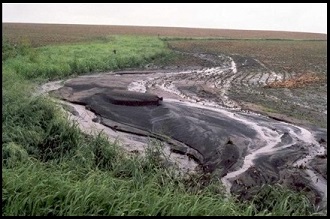Watershed Protection
IN SOUTH DAKOTA
About Section 319


Before and after pictures of Seasonal Riparian Area Management on Skunk Creek.
The Clean Water Act was amended in 1987 by Congress to add Section 319, which is now the primary focus of state nonpoint source programs. The Section 319 Nonpoint Source Management Program provides the means for states, tribes and territories to receive federal funds to address nonpoint source pollution. 319-funded projects are the primary channel for reducing nonpoint source pollution in South Dakota. Other sections of the Clean Water Act such as 104(b), 106 and 604(b) provide additional grant opportunities, each with its own focus such as assessment or research. Section 319 grant funds may be used for watershed assessment, planning and implementation, groundwater protection or for information and education projects dealing with nonpoint source issues. Implementation refers to putting best management practices (BMPs) in place to reduce nonpoint source pollution, often in response to an existing TMDL. South Dakota prioritizes areas that have impaired waters with TMDLs for first consideration of funds. Local and in-kind sources must match at least 40% of the funds to the project. The project must be led by local entities such as local government, tribes, nonprofit organizations, universities and colleges, or by concerned citizens. Education of the public and water quality monitoring, if applicable, are required elements for 319-funded projects. Guidance on how to apply for 319 funds is available here.
After applications are received in October, state staff make recommendations to the citizen-advisory group, called the Nonpoint Source Task Force, to identify suitable water quality improvement projects to fund the following year. The Nonpoint Source Task Force makes recommendations to the Board of Water and Natural Resources to submit these projects to the Environmental Protection Agency for grant approval. Approved projects must meet reporting requirements, meet annual milestones, and report reductions in sediment, nitrogen, and phosphorus. Reports from past 319 projects are available here. For more than 25 years, the 319 Program has been developing and implementing watershed restoration projects throughout the state to improve water quality.